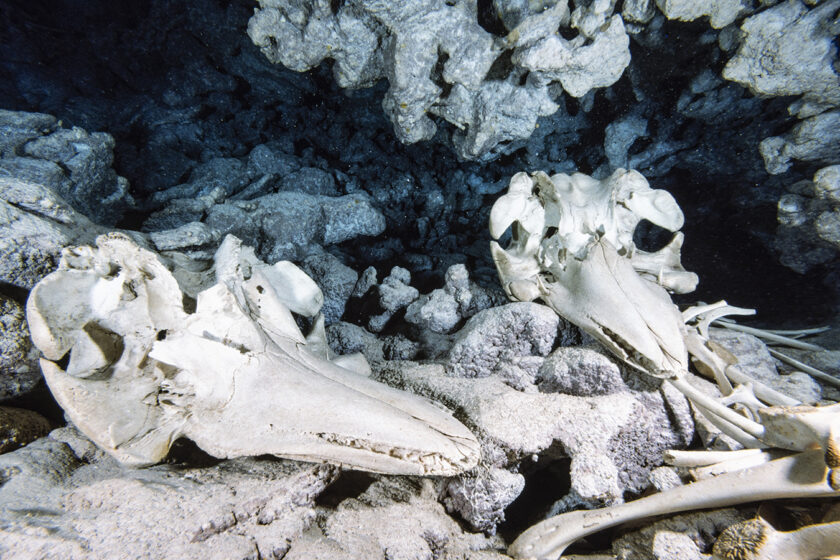Ever look back on an experience and asked yourself “if I knew then what I know now, would I have still done this?” Everybody usually has a good diving story to tell involving something highly risky. Mine involved diving a deep underwater cave system containing the bones of four whales that parish inside for a filming expedition in 1992 in the northeastern region of the Fiji Islands.
The descent down the wall was like a slow-motion freefall along the side of a sheer cliff. There was hardly anything living, growing, hanging or swimming along its face. Strange, considering how the rest of walls in these waters are characteristically brimming with life and color. Straight below, the view held only the dark blue nothingness of the depths. At 110 feet, the wall began its deep inward turn toward the cavern entrance.
Dropping perhaps a little too fast, we overshot our was targeted depth of 165 feet (shallowest point for us to enter) by 20 feet. In front of us the cave’s ominous, black opening was now in full view.
It was immense!
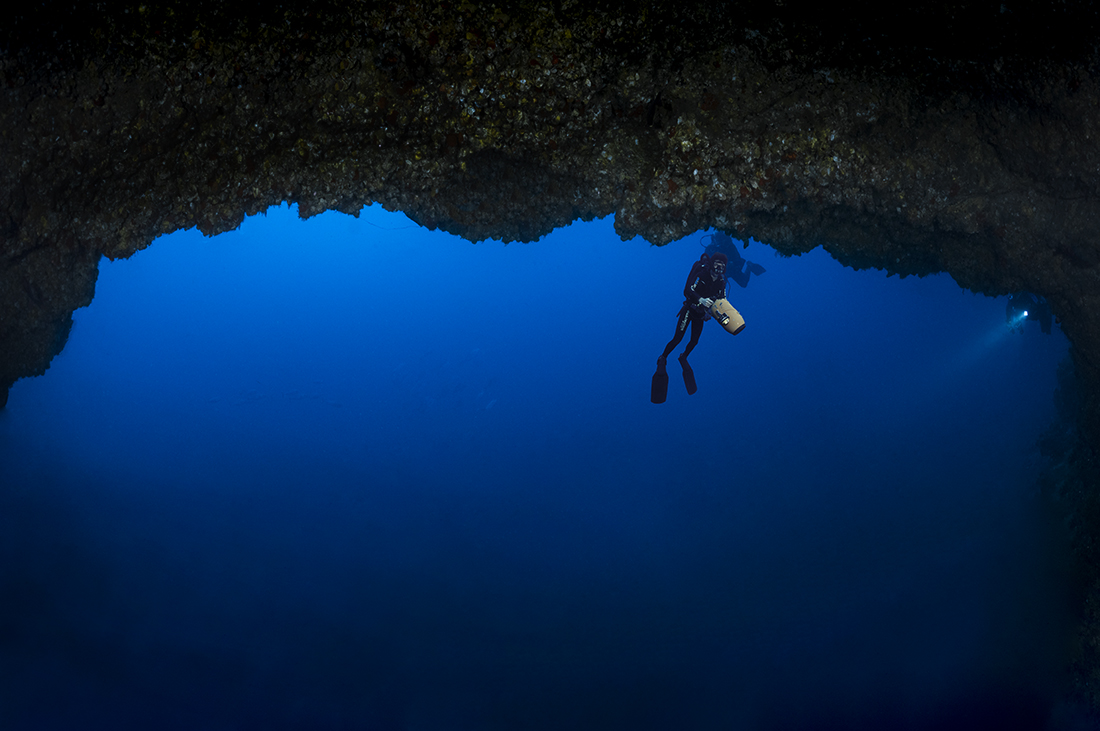
Extending from a depth of 165 feet down to more than 230 feet. Big enough fit the Matagi Princess II, all 80 feet of her whole. Beyond the shear scope of its’ opening waited a mystery which nearly defies comprehension, the skeletal remains of four whales tucked away deep within this depression. Since this would be our first penetration, an exploratory one at that, I was already feeling more than a slight tinge of apprehension.
As first recounted by Nigel and Carol Douglas two years before, I was to say the least, highly intrigued. First of all, the details of their discovery simply blew me away. Like so many remarkable things on this planet, the cave’s location was revealed by accident during a dive site scouting mission around the Ringold Islands, east of Fiji’s second largest island, Vanua Levufor their new dive live aboard the Matagi Princess .
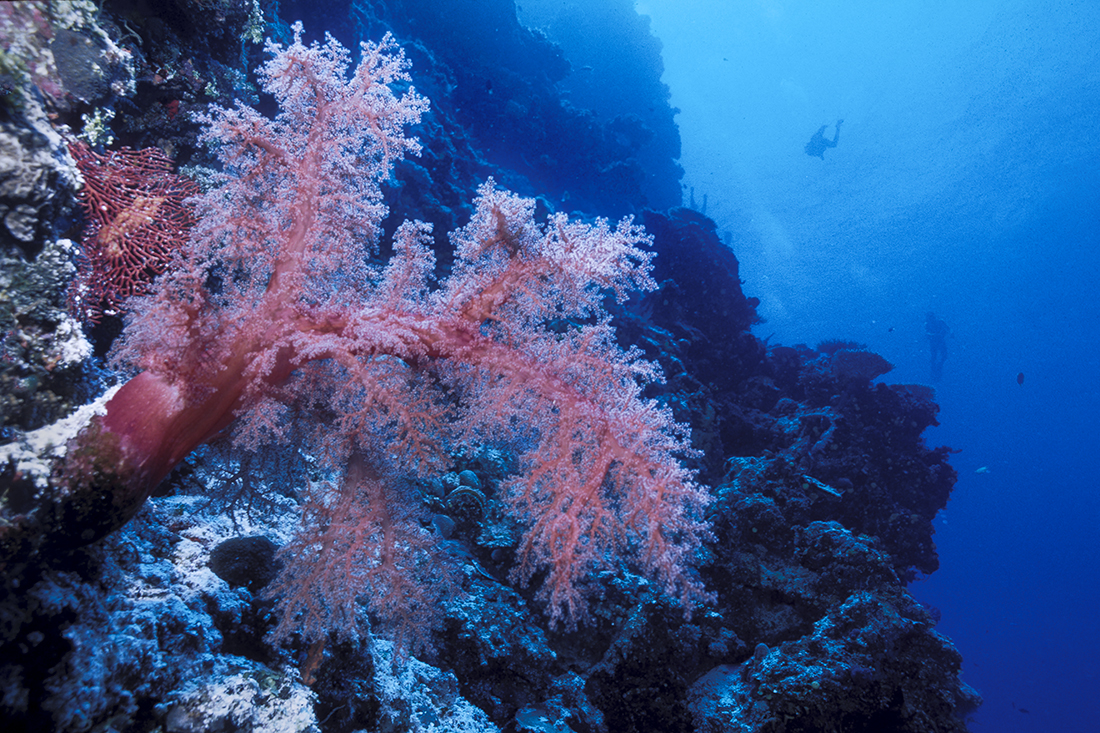
The reef systems of the Fiji Islands are notorious for sudden plunges straight down, often starting just below the ocean surface. While following the contours of such a system, the Douglas’s sighted a large cave opening in the side of the wall. Seeing the immense opening, as well as its position, sparked their curiosity. Returning the next day with a battery of tanks, lights, lines and a plan, a preliminary exploration of the cave was accomplished. It was during this initial probe that they made their gruesome find. At first sight, they were in virtual disbelief. Following the initial shock were questions such as, what exact species of whale do these skulls depict? Measuring more than 1-1/2 feet across, they are far too large to belong to dolphins. With the help of Australian photographer and friend Kevin Deacon, it was soon learned that the ill-fated remains belong to a small pod of Short-finned Pilot Whales (Globicephala macrorhynchus).
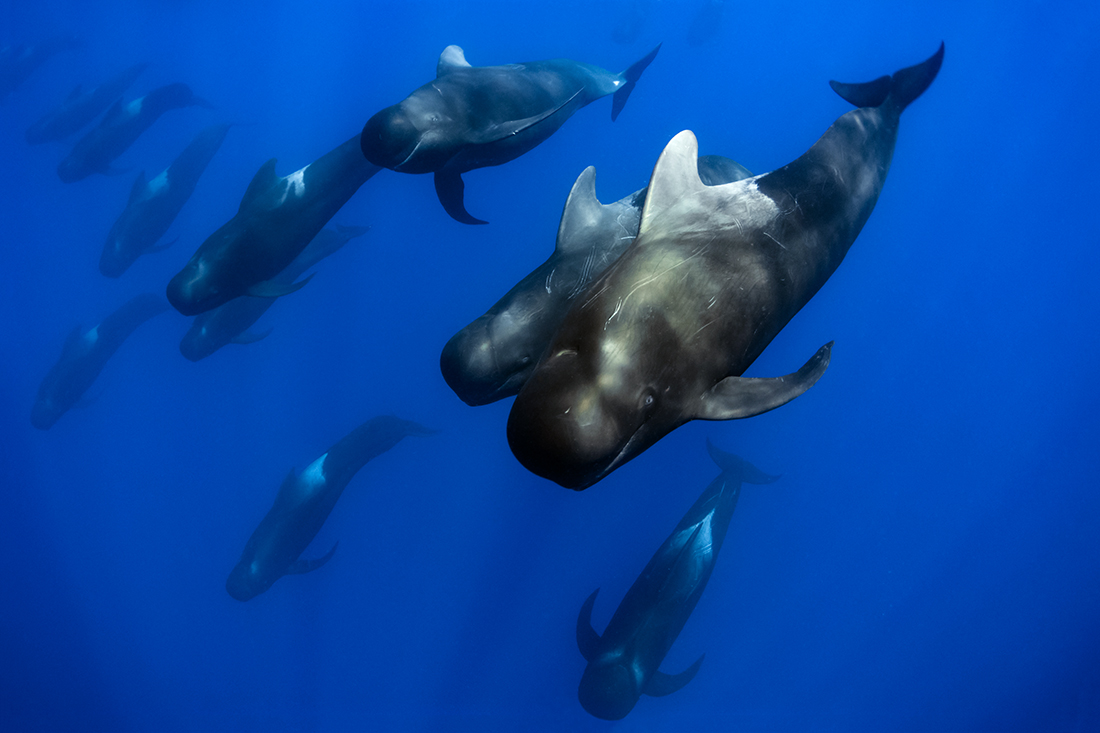
Since that time some five years ago, the Douglas family have overseen the security of this unique and unexplained treasure. There has been no additional exploration, with the exception of a short visit by the Cousteau’s Alcyone Dive/Film Crew for a documentary episode. Recently, however, underwater cinematographer John McKenney was granted special permission to penetrate the cave by both the Fijian Government and the Douglas Family. As part of the film crew, I joined in on this concerted effort to bring about an awareness and understanding of the phenomenon for the Discovery Channel’s “Secrets of The Deep” series.
As we readied ourselves to enter, I recalled the descriptions of what to expect. From the entrance, the ceiling of the cavern would extend straight back some 60 feet before making an abrupt, angled climb for another 100 feet. This sloping floor would reveal the first remains – the partially intact skull of an adult animal located within sight of the entrance at a depth of about 120 feet. A second and more intact specimen would be farther up the slope at a depth of 103 feet, marking the base of a vertical chimney that ascended straight up another 40 feet. This chimney would then end at a series of three narrow cracks which branched off into even more cramped dead ends. The two remaining skeletons were reputedly up one of these splits in a small chamber at a depth of 63 feet.
Here’s the fun part; from this final point of the passage, the most apparent route out (not to mention the only one) was to go back exactly the same way we came in. In theory, in the event of light failure and/or a silt-out, one solution to help assure we were going the right way, would be to dump the air from our BC’s and trust gravity to do its thing. In this way, we would literally free fall to the exit and out. After all, down is out.
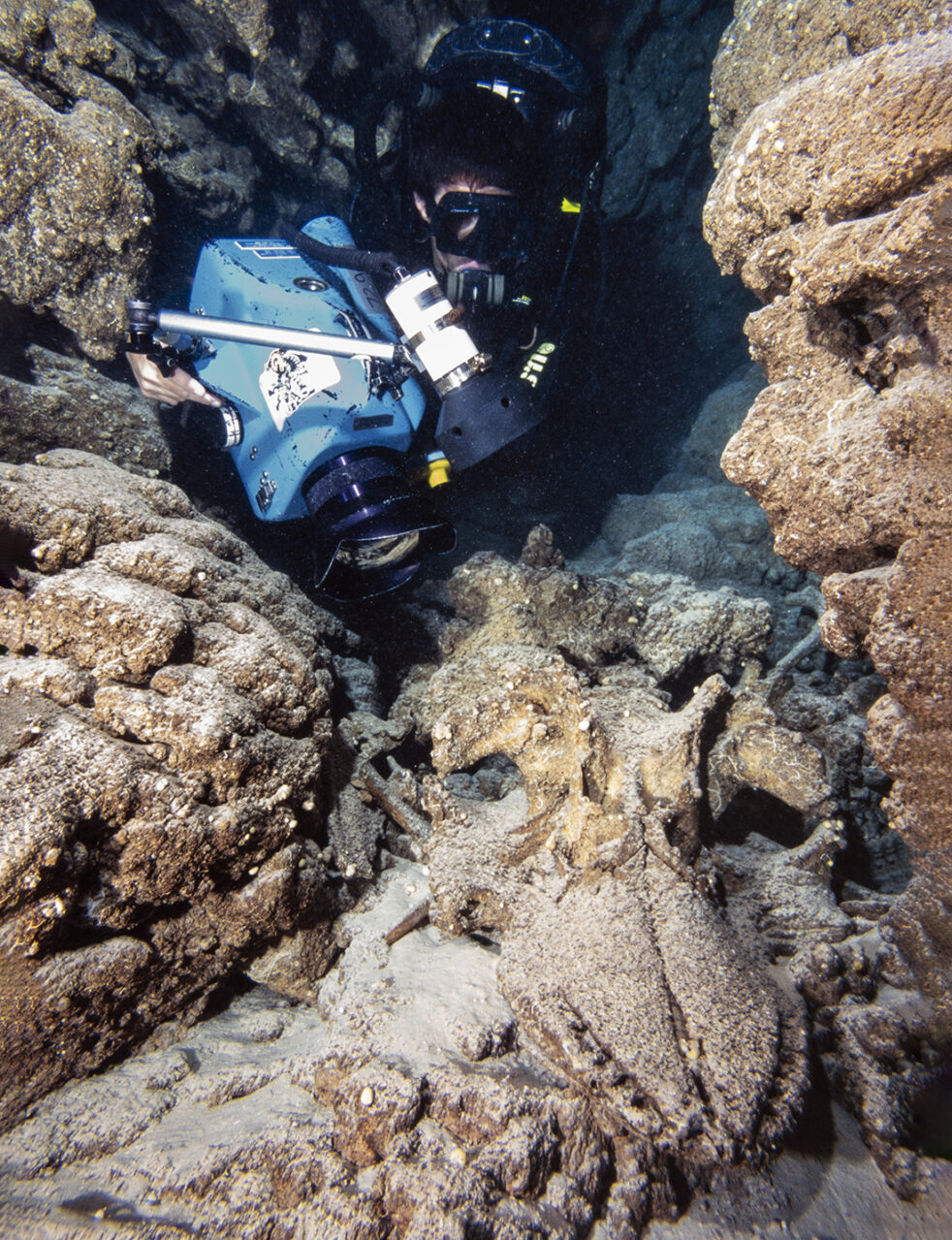
We somehow overshot the first set of bones, then at a depth of 103 feet found the second. Like the iconic cow skull marking a pool of poison water, it was our first reminder that this was a dangerous place. Heavily encrusted with calcium nodules, the skull seemed more like a fossilized, prehistoric beast than a pilot whale. Judging by the skull’s two-foot width, it was most likely a bull. Reaching for a giant vertebrae next to it, I discovered that it was fused solidly to the surrounding rock. I wondered how long had it had been there.
Below and behind us, the cave entrance was now just a small, deep-blue disc in the distance.
As mapped out earlier, five minutes from now, our first team of support/safety divers, consisting of Norren McKenney and camera assistant Eric Scharmer, would make their ascent up through the opening, carrying with them two more sets of back-up tanks to this very spot. Adding to the fact that we faced a long decompression, team two, comprised of three more divers with a larger battery of tanks, waited our return at the appropriate time outside the cave at our first deco stop.
Logistically, this was a complex dive, and any deviation from the tightly-orchestrated plan could make for a really bad day.
After examining the skull, we moved farther into the cave. As we ascended into the chimney, the walls closed in. John took the lead and we continued single file, using our hands to fend off the walls, more like climbers than divers. The chimney spiraled, the walls taking on an intricate, popcorn-like appearance. Overhead, three large fractures appeared, and we faced a dilemma. Of the three passages above, one angled sharply to John’s right, we’d been told that the remains would be located in the right-hand passageway. But the twisting ascent of the chimney had turned us around, leaving us with no idea which tunnel might be the “right” one. Our planned dive time, not counting deco, was 24 minutes, and the clock was ticking. A wrong choice would cost precious minutes, or worse.
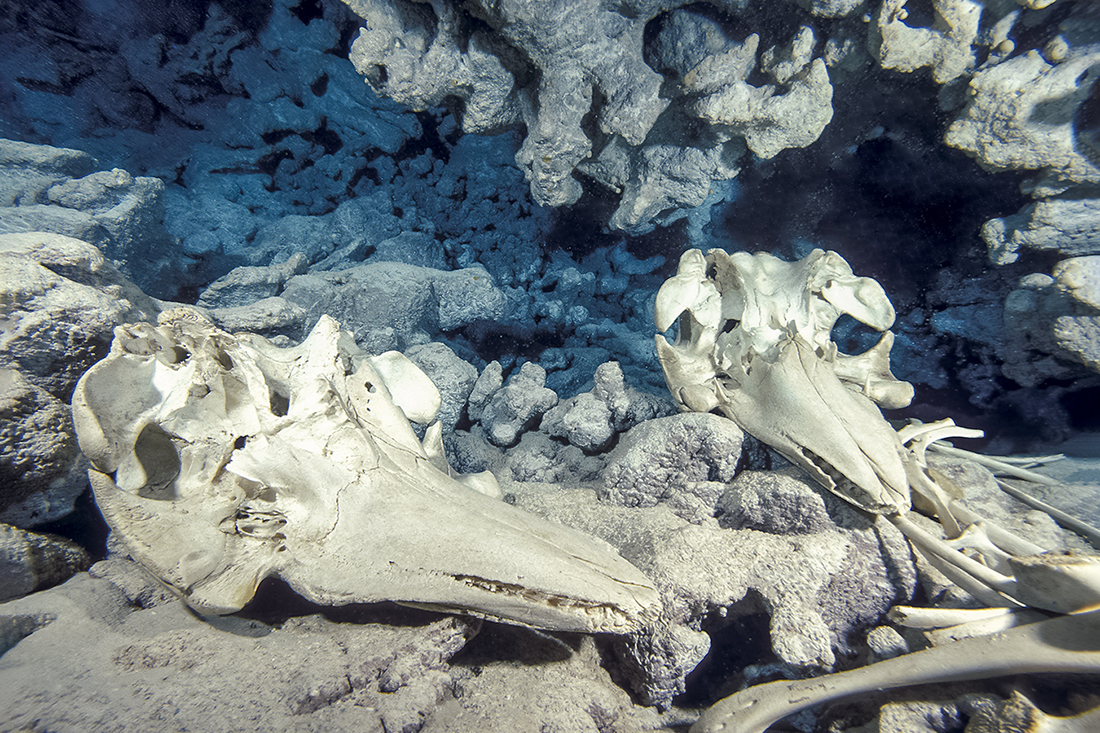
John tried the first passage with no success. I took the lead on the second, carefully pulling my way through 10 feet of narrow tunnel to reach a small shelf level with my head. Aiming my light, I was met by the vacant, ghostly stare of two skulls facing straight back at me. I felt a sense of triumph in finding the skulls, but also sadness for their demise. I wondered what on earth could have possessed or caused these creatures to wander into this tiny crevice and end their existence in this fashion.
There wasn’t time to ponder the whale’s fate. The deco clock was running, we were several hundred feet up inside a cave with little elbowroom, a limited air supply, millions of metric tons of rock over our heads, and the only escape being to drop back to a depth of 165 feet. After firing off several frames, it was time to leave.
Dropping back down the chimney with John in the lead I was relieved to see Norren and Eric had arrived and waiting for us at a depth of 110 feet. By my computer, an Aladin Pro that works off a Buhlmann haldanian algorithm air profile showed I had raked up 16 minutes of decompression with still more to come by the time we passed through the opening another 60 feet below.
With the initial exploration out of the way, we could now form a strategy for the remaining dives. But for the moment, that didn’t matter as we four glided down the cave’s wide corridor. Seeing the deep blue glow of the entrance expanding before us was one of the most welcome, beautiful sights ever to mark the end of a dive.
A Challenging Environment
Over the course of two days, John and I made four dives into the cave, supported by our two teams of safety divers. We were able to capture the footage needed to make the project a success, but there were plenty of challenges. Filming in the narrow, uppermost confines of the cave required us to pair our gear down to a single, over-charged 80, and no matter how careful we were, it seemed that something was getting hung up or scraped against the rocky confines of the tunnels. It took great care to keep lights and camera lenses safe, not to mention ourselves. Each dive ended with decompression obligations of more than 40 minutes; there was no supplemental in-water oxygen for an added safety margin, and the nearest chamber was days away.
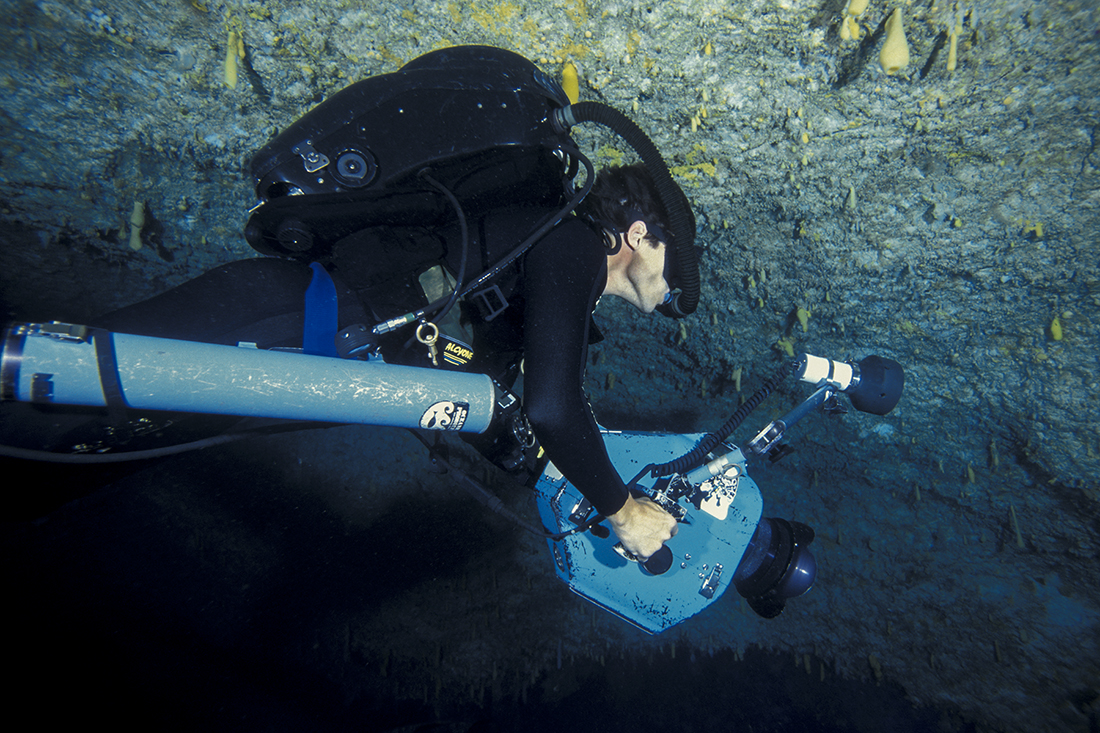
During our fourth and final dive, I suddenly experienced a profound sense of uneasiness. It was as if the spirits of the whales had been disturbed, and wished us to leave. Stranger yet, I was not alone. At the end of the dive, John turned to me and remarked, “Maybe its just me, but I felt as if we were no longer welcome.”
The Riddle of the Cave
As a rule, dolphins and whales will not swim into an underwater cave or anything resembling one. Even trained, captive cetaceans, with total faith and trust in their trainers will show a serious reluctance to do so. I witnessed this reluctance firsthand while working at the Miami Seaquarium, where a short passageway connected the main dolphin tank with a smaller satellite tank. A 10-foot section of that connecting flume had a ceiling, while the rest was open. Invariably, when dolphins were moved into the flume, they would balk at the enclosed section, and no amount of coaxing by a favorite trainer could convince them to swim through. This behavior included dolphins that had been in the Seaquarium their entire lives, and literally knew every nut and bolt in the tank.
So, the question remains: why would whales swim far into a deep, dark cave? Initially, we envisioned the scenario of a failed rescue attempt for a lost calf. One of the two skulls in the uppermost reach of the cave was noticeably smaller than the remaining three, making it most likely an adolescent. The second, being larger, but still smaller than that of the bull’s skull found in the lower end of the chimney, could have in turn been the younger animal’s mother.
During surface intervals, we’d concocted a plausible scenario. For survival in the open sea, pilot whales rely heavily on a tight knit social order, and where one goes, they all go. Even healthy individuals will sometimes strand themselves on a beach with the rest of the herd that is either sick or disorientated. Furthermore, when a cow has a calf, typically a second female, or what is termed as an auntie, will help rear that calf. Those facts point to a possible scenario in which a calf somehow wandered into the cave, only to become lost. Hearing its whistles and screams of panic sent not only the calf’s mother into the cave after it, but also the calf’s auntie, and conceivably the pod’s dominate bull.
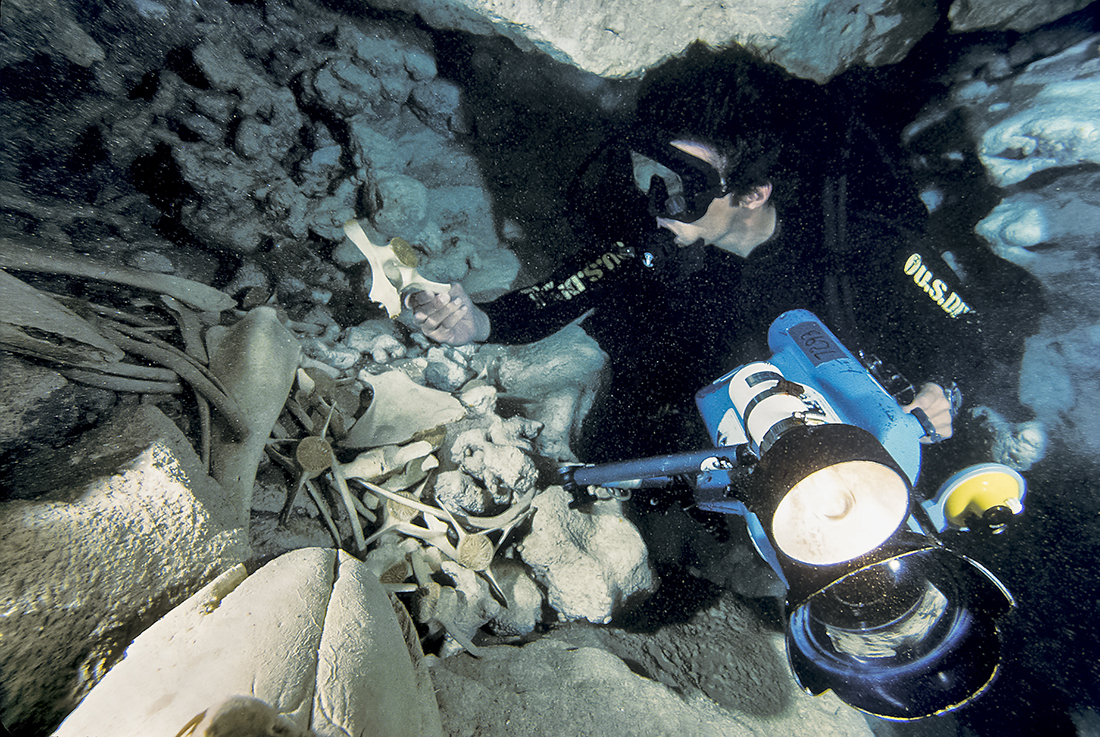
In addition to trying to understand what might have sent the animals into this particular cave, there was a second riddle to the scene; the placement of the skulls. The first part of the puzzle – all the skulls were discovered resting upside-down. Even more tantalizing is that all four (particularly the two in the uppermost chamber) were found to be facing in the same direction as their two compatriots in the lower levels of the cave! As if in their final moments of life, they knew which way was out. This most definitely stirs the emotions. And what a series of emotions we felt.
It was a tragic yet compelling scenario – but ultimately wrong. During the final dive, a couple of bones samples were taken from each of the four skeletons, which were then sent to a lab for radiocarbon dating. The results were completely unexpected. It was determined that the two smallest whales found deepest in the cave belonged to an adolescent less than two years old, and an even younger calf. And based on the levels of carbon-14 remaining in their bones, their time of death was estimated to be the mid 1970s. The same dating techniques revealed that the remains closest to the entrance belonged to an adult who died some 2,700 years ago – 700 years before Christ, while the largest skeleton of the four, the one we’d nicknamed “big bird,” was roughly 3,800 years old – dating back to the days of the Egyptian pharos.
These facts created more questions than answers and provided fodder for a variety of theories and scenarios. In the end, we had no idea what really lured these whales into darkness and death – we were simply thankful that our intrusion into this submerged tomb did not lead to the same fate.
Some mysteries may never be answered.
The film Mystery of the Whale Cave is available on YouTube –

